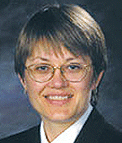Technology + Online + Industry + Partnerships
Winners of High-Tech Projectors Prepare to Wow Students
Our contest victors lay out their plans for using the technology in the classroom.

PROJECTING SUCCESS:
Our winners plan for new capabilities.
IN THE NOVEMBER edition of In Brief, T.H.E. Journal announced it would award Canon REALiS X600 multimedia projectors to three schools with “compelling study challenges” that were intent on “innovative use of the projection technology.” Our three winners have been selected. Here they are, along with their plansfor making the most of their new projectors.
Matt Sly, Urbana High School (IL). Sly, a physics teacher, says his school has an“extremely limited” technology budget, andthe new Canon projector will replace a verydated projector that has to serve a wide varietyof classes. Sly looks forward to introducingthe REALiS X600 to his science students.“I have a number of ideas I will use it for inmy department,” he says, “including examiningmodels and simulations that most projectorsdo not provide enough resolution to makeout images clearly. Another benefit for thephysics classes would be taking advantage ofthe projector to study stop-frame images ofmotion with the benefit of a high-qualityprojected image.”
Diane Knowles, Eastside Elementary School (TN). Knowles, who teaches third grade at the preK-8 Eastside Elementary School, wants to use her new projector to take her students on virtual field trips, to project stories from an online subscription service so they can read aloud in class, and to show otherwise minuscule images, online movies, and presentations—and “not just to those who can crowd around the computer,” she adds. She is excited to give each of her students, simultaneously, the feeling of “seeing the detail of the item on the screen as if they were the one holding it.” Also, she says,“Our new science-and-rocketclub could really use theequipment to ‘take off.’”Eastside’s need is particularlygreat. More than half thestudents qualify for free- orreduced-price lunch programs,according to Knowles, and educationalexpenses are often coveredby parents and teachers themselves, who areamong the lowest paid in the state.
Vickie Ahearn, Massapequa High School (NY). Identifying a different type of need, Ahearn, an art teacher, says, “Imagine trying to teach art—without art. Holding up pictures from the internet, working out of a library book, or watching a movie on a small monitor does not have the proper impact.”
Ahearn already has specific plans for her new projector—for example, to teach perspective.“By projecting digital images of buildingexteriors and interiors, using a whiteboard andpens in different colors,” she says, “studentscan identify and mark the vanishing point;horizon line; and parallel, horizontal, and verticallines.” She adds that if she then turns theprojector off, her class will “see” the linesdrawn in perspective. “Seeing the basic principlesof perspective on a large scale makesthis lesson more engaging and dynamic.”
GOOGLE FREEBIES TO BENEFIT K-12 EDUCATORS SOME TECH COMPANIES give away pens or squishy toys emblazoned with a logo. Not Google. The producer of the internet’s most popular search engine is giving away free online software—and not demos or games, but useful applications usually bought and installed locally, such as a word processing programand a spreadsheet program.
Google is promoting these products in K-12 classrooms—and it’s not even allowing ads to be included with the free software. The company isn’t expecting a big fiduciary payoff, at least not in the near term. The project is more like an investment in the community, a boon to educators who don’t have the funds to provide students all the tech tools they’d like to. Google has provided teachers a free guide to integrating its products into lesson plans, and has also hosted about 50 teachers who live near its Mountain View, CA, headquarters for a day at the office, to learn more about the company’s educational resources.
Google’s free programs may even exceed the benefits of traditional desktop applications. For example, the word processing app allows multiple students to simultaneously view and work on the same document, and users’ files are stored in Google’s data center, so they can be retrieved from any internetconnected computer.
Is there a downside? Software retailers might say so.
:: Industry News
YELLOW PAGES ADDITION A SIGN OF THE TIMES. AT&T Yellow Pages has announced that the rise of virtual education in 2006 has necessitated the addition of a new heading to its print directories— “Online Schools.” The change is a good indicator of a marked trend, since a new heading is added only after a headings product team deems that a critical mass is active in the industry, andchances are strong for growth.
TEACHERS SPEND PERSONAL FUNDS. Quality Education Data, a division of educational publisher Scholastic, has released a study that says K-12 teachers spend, on average, personal funds amounting to $475 per year on classroom supplies and materials. Elementary school teachers spend the most, at $539. Middle and high school teachers spend $393 and $427, respectively. The study shows that teachers spend their own money on student rewards, classroom decorations, and professional materials, while school funds are used to purchase computer software and workbooks.
LOCKDOWN ALERT TEXTS PARENTS IN CASE OF EMERGENCY. Lockdown Alert supports more than 94,000 public schools with its free, cell phone-based emergency notifi- cation system. The system sends a text message to parents when an emergency occurs at school. There is no charge to schools or parents for the advertiser-supported system.
:: Partnerships

HAVING A FACE-TO-FACE:
Hewlett-Packard and Tandberg are
teaming up to share video resources.
HP AND TANDBERG FORGE ALLIANCE. PC giant Hewlett-Packard and Tandberg, a leader in visual communication systems, are joining forces to make their respective telepresence and videoconferencing portfolios interoperable. Plans are in place to enable Tandberg’s videoconferencing system to work on the HP Halo Video Exchange Network. The advantage for Tandberg customers will be the use of video apps without the need for further investments in internal IT resources or upgrades to corporate networks. For HP Halo customers, the draw is a broadersuite of collaboration solutions.
ED TECH VENTURES BECOME PARTNERS. Spectrum K12 School Solutions, maker of software for special education, and Edustructures, a schools interoperability framework (SIF) solutions provider, have entered into a partnership to provide enhancements to instructional, administrative, and communications technologies in schools. The companies say they will be working together to bring a more comprehensive, SIF-compliant special-education data management solution to districts and educational service centers, based on Spectrum K12’s Encore data management system and Edustructures’ SIFWorks Integration Platform. SIF enables educators to integrate new software intosystems they’re using.
SCHOOL/VENDOR PARTNERS TO LAUNCH SATELLITE. The Thomas Jefferson High School for Science andTechnology in Alexandria, VA, willteam up with satellite maker Orbital Sciences Corporation to launch the first-ever studentbuiltsatellite. The program is designedto inspire high-achieving high schoolstudents with hands-on experience thatwill introduce them to the challengesand wonder of space.

HEADSET TECH: WhisperPhones clarify phonemes.
BALTIMORE SCHOOLS RECEIVE WHISPERPHONES. Harebrain, in partnership with Progressus Therapy, a provider of school-based pediatric therapy, will donate 1,500 of its WhisperPhones to the Baltimore City Public School System. WhisperPhones are audio-amplification devices used to help students develop phonemic awareness. They work by amplifying a student’s voice and conveying it to one ear via headsets that can be operated hands-free.
:: People
SIBONEY LEARNING GROUP ANNOUNCES PROMOTION. A 14-year veteran of the educational software industry, Jan West has accepted the position of sales director for Siboney Learning Group’s Educational Activities Software line. She will be responsible for all of the sales and marketing of EAS products, which are geared toward middle schoolers, high schoolers, andEnglish language learners.

David Martin
SMART MAKES C-LEVEL CHANGES. Smart Technologies, maker of the Smart Board interactive whiteboard, has announced a new president and COO in accordance with the company’s decision to separate the roles of president and CEO.

Nancy Knowlton
Tom Hodson, the former vice president of marketing, will step into the role of president and COO. Smart co-founder David Martin, the former chairman and co-CEO, is moving to the position of executive chairman. Nancy Knowlton, co-founder and former president and co-CEO, is now the sole CEO.
:: New to Market
HORIZON WIMBA LAUNCHES PRONTO. Horizon Wimba, developer of webbased collaboration software, has released Pronto, a free instant messaging and voice chat tool aimed at educators and students. Pronto works with course management systems, such as Blackboard and WebCT, to automatically populate students’ contact lists with their classmates’ names, making it easier for students to collaborate online. Access privileges are also created automatically based on a school’s course management system. Pronto features IM, VoIP, and group IM andgroup VoIP.
WEBSITE DELIVERS NEWSFLASHES. TeacherWeb.com has introduced a“NewsFlash” page so teachers andschool administrators can broadcast latebreakingnews, such as the announcementof a snow day, to parents andstudents. Just a click of a mouse cansend a message instantly to everyone onthe site’s e-mail and cell phone lists.
BESTQUEST RELEASES NEW MATH COURSEWARE. Manufacturer of the popular Algebra’scool, BestQuest Teaching Systems, creator of DVD-based learning courseware, has released a prequel dubbed Math’scool. Math’scool provides prealgebra instruction through graphics, diagrams, models, and real-world problem solving.